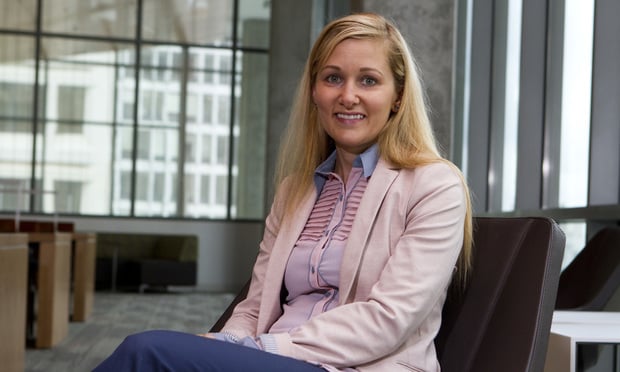GSU Law Deploys Data Analytics to Boost Bar Pass Rates
Researchers are using predictive modeling so they can identify law students who are statistically at risk—and offer assistance.
April 12, 2018 at 02:36 PM
6 minute read

Georgia State University College of Law is taking a high-tech approach to the troubling national phenomenon of declining bar pass rates.
The law school is developing a program that uses data analytics to identify students most at risk for failing the bar exam. To do that, it's compiling a comprehensive database that tracks pass rates for its recent graduates, starting with the class of 2012, against their grades, classes taken and a multitude of other factors, such as time spent on bar preparation.
With that predictive modeling, the researchers hopes to pinpoint and suggest interventions for students who are statistically at risk after their first year of study.
'Scared Straight'
Jessica Gabel Cino, GSU Law's associate dean for academic affairs, is leading the program. She said one early finding is that material covered in Constitutional Law II, an elective covering due process and individual rights, is “one of the weakest points” for students taking the bar exam. Questions about wills, trusts and estates are also often on the exam—but that course is elective.
“You can't learn that in six weeks,” Cino said, so she will “strongly encourage” a student who appears at risk to take those courses.
Cino said waiting until a student has graduated and is preparing for the bar exam is too late.
“I want to be able to tell you after the first year of law school if you're at risk for failing the bar and that you need to do something—and do something now,” she said.
GSU Law has already established a mandatory daylong “boot camp” in January for third years, Cino said, where they take a diagnostic exam. “They see how bad the bar exam is, so they're 'scared straight.'”
But Cino wants to start pinpointing possible trouble spots for students and ways the law school can help as early as possible.
“In law schools, it's not only our job to make sure they're doing well in the silo of law school. We've really got to help address the bar pass issue,” Cino said.
“It's not enough for me to tell them to study harder. I need to give them a realistic picture of why study harder—and give them the resources,” she said.
GSU Law has also hired Kim D'Haene for a new position as director of academic success to assist in developing programming and individual plans for students. D'Haene is a lecturer for Kaplan Bar Review and was assistant dean for academic achievement at Atlanta's John Marshall Law School.
Pass Rates in Decline
When Cino took on the academic affairs position from Roy Sobelson in 2016, GSU Law had started to see the same concerning drops in its bar pass rates as other law schools.
The bar pass rate for the GSU Law graduating classes of 2012 to 2014 was high, ranging from 95 percent to 92 percent, respectively, for first-time takers of the July exam, according to data from the Georgia Office of Bar Admissions. It dropped to 87.5 percent for the 2015 class, then 82.6 percent for the 2016 class—rebounding slightly to 84.5 percent for the 2017 class.
Even so, GSU Law has the second-highest pass rate of Georgia's five law schools, behind the University of Georgia School of Law.
Bar pass rates for Georgia law schools started to drop in 2013, from an 89.8 percent average pass rate in July 2012 for their first-time test-takers to 75.3 percent for the same group for the July 2016 exam, according to Georgia Office of Bar Admissions statistics.
That's a decline of 14.5 percentage points in that four-year period.
In a positive development, the pass rate for the July 2017 exam rebounded to 79.4 percent for first-time takers from Georgia law schools.
Deploying Data
Meanwhile, GSU researchers had been using analytics tracking to improve graduation rates for its undergraduate class, Cino said, by “identifying the pressure points for students not graduating.”
What the researchers found was that college algebra was a big obstacle, so GSU devoted resources to math tutoring, she said.
Another big obstacle was money. As little as $500 could make a notable difference in undergraduates completing their degree, the researchers found, so GSU offers microloans now.
As a result, the university increased its four-year graduation rate by 9 percentage points from 2011 to 2016.
“Why not build on this amazing work?” Cino said. “We're hoping to do the same with our project and find out what are the pressure points for law students.”
The only real consensus on the problem is that it's “a multitude of factors,” she added.
Cino and a team of student researchers started compiling a database of grades, coursework and bar pass rates at the beginning of the year for the roughly 1,750 students enrolled from 2009 to 2017. That data sample includes earlier classes with high pass rates, which they can compare to the classes for which pass rates declined.
“You need to look at students in years with good bar results and bad bar results so you can make informed decisions,” Cino said.
Cino and GSU professor Andrea Curcio secured an AccessLex Institute/AIR grant to assess whether LSAT scores predict success in law school and on the bar exam, which is helping to fund data collection and inputting.
The law school is also conducting qualitative research. Cino and her team are crafting a questionnaire for all 1,750 of those students and recent alumni that will ask how they studied for the bar, if they are single or married, and what financial pressures they were under.
All those factors and more, Cino said, “play into students' ability to achieve success in law school.”
One factor, she added, could be that students these days don't necessarily take a lot of law classes that “put them in a closed-book, time-test environment,” akin to the bar exam, as schools and students focus more on practical lawyering skills.
For that reason, the survey will ask students how much time they are spending on bar prep. Two popular prep courses, Kaplan Bar Review and Barbri, use online software that tracks students' homework completion, which they can opt to share with the law school. “That's really helpful,” Cino said.
Cino said she and her team hope to have data collection and entry completed by the end of May so they can start running predictive models, with help from GSU data scientists.
This content has been archived. It is available through our partners, LexisNexis® and Bloomberg Law.
To view this content, please continue to their sites.
Not a Lexis Subscriber?
Subscribe Now
Not a Bloomberg Law Subscriber?
Subscribe Now
NOT FOR REPRINT
© 2025 ALM Global, LLC, All Rights Reserved. Request academic re-use from www.copyright.com. All other uses, submit a request to [email protected]. For more information visit Asset & Logo Licensing.
You Might Like
View All
Sunbelt Law Firms Experienced More Moderate Growth Last Year, Alongside Some Job Cuts and Less Merger Interest
4 minute read
Fowler White Burnett Opens Jacksonville Office Focused on Transportation Practice
3 minute read
Georgia High Court Clarifies Time Limit for Lawyers' Breach-of-Contract Claims
6 minute read
Southeast Firm Leaders Predict Stability, Growth in Second Trump Administration
4 minute readTrending Stories
- 1Florida Judge Tosses Antitrust Case Over Yacht Broker Commissions
- 2Critical Mass With Law.com’s Amanda Bronstad: LA Judge Orders Edison to Preserve Wildfire Evidence, Is Kline & Specter Fight With Thomas Bosworth Finally Over?
- 3What Businesses Need to Know About Anticipated FTC Leadership Changes
- 4Federal Court Considers Blurry Lines Between Artist's Consultant and Business Manager
- 5US Judge Cannon Blocks DOJ From Releasing Final Report in Trump Documents Probe
Who Got The Work
J. Brugh Lower of Gibbons has entered an appearance for industrial equipment supplier Devco Corporation in a pending trademark infringement lawsuit. The suit, accusing the defendant of selling knock-off Graco products, was filed Dec. 18 in New Jersey District Court by Rivkin Radler on behalf of Graco Inc. and Graco Minnesota. The case, assigned to U.S. District Judge Zahid N. Quraishi, is 3:24-cv-11294, Graco Inc. et al v. Devco Corporation.
Who Got The Work
Rebecca Maller-Stein and Kent A. Yalowitz of Arnold & Porter Kaye Scholer have entered their appearances for Hanaco Venture Capital and its executives, Lior Prosor and David Frankel, in a pending securities lawsuit. The action, filed on Dec. 24 in New York Southern District Court by Zell, Aron & Co. on behalf of Goldeneye Advisors, accuses the defendants of negligently and fraudulently managing the plaintiff's $1 million investment. The case, assigned to U.S. District Judge Vernon S. Broderick, is 1:24-cv-09918, Goldeneye Advisors, LLC v. Hanaco Venture Capital, Ltd. et al.
Who Got The Work
Attorneys from A&O Shearman has stepped in as defense counsel for Toronto-Dominion Bank and other defendants in a pending securities class action. The suit, filed Dec. 11 in New York Southern District Court by Bleichmar Fonti & Auld, accuses the defendants of concealing the bank's 'pervasive' deficiencies in regards to its compliance with the Bank Secrecy Act and the quality of its anti-money laundering controls. The case, assigned to U.S. District Judge Arun Subramanian, is 1:24-cv-09445, Gonzalez v. The Toronto-Dominion Bank et al.
Who Got The Work
Crown Castle International, a Pennsylvania company providing shared communications infrastructure, has turned to Luke D. Wolf of Gordon Rees Scully Mansukhani to fend off a pending breach-of-contract lawsuit. The court action, filed Nov. 25 in Michigan Eastern District Court by Hooper Hathaway PC on behalf of The Town Residences LLC, accuses Crown Castle of failing to transfer approximately $30,000 in utility payments from T-Mobile in breach of a roof-top lease and assignment agreement. The case, assigned to U.S. District Judge Susan K. Declercq, is 2:24-cv-13131, The Town Residences LLC v. T-Mobile US, Inc. et al.
Who Got The Work
Wilfred P. Coronato and Daniel M. Schwartz of McCarter & English have stepped in as defense counsel to Electrolux Home Products Inc. in a pending product liability lawsuit. The court action, filed Nov. 26 in New York Eastern District Court by Poulos Lopiccolo PC and Nagel Rice LLP on behalf of David Stern, alleges that the defendant's refrigerators’ drawers and shelving repeatedly break and fall apart within months after purchase. The case, assigned to U.S. District Judge Joan M. Azrack, is 2:24-cv-08204, Stern v. Electrolux Home Products, Inc.
Featured Firms
Law Offices of Gary Martin Hays & Associates, P.C.
(470) 294-1674
Law Offices of Mark E. Salomone
(857) 444-6468
Smith & Hassler
(713) 739-1250






